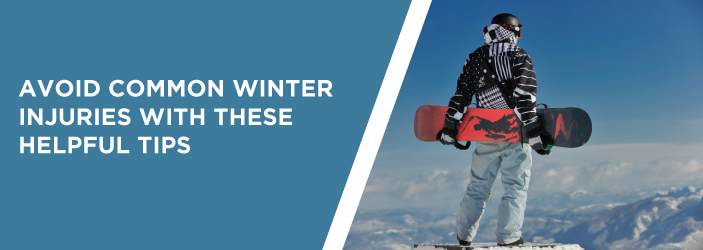 If you’ve experienced an injury or pain while performing a wintertime activity, you are not alone. Personal injury during winter is likely to occur from performing simple activities, especially if you aren’t prepared to prevent an incident. From your back, shoulder and neck to joints and knees, pain and injury in these areas are commonplace during the winter.
If you’ve experienced an injury or pain while performing a wintertime activity, you are not alone. Personal injury during winter is likely to occur from performing simple activities, especially if you aren’t prepared to prevent an incident. From your back, shoulder and neck to joints and knees, pain and injury in these areas are commonplace during the winter.
The good news? Preventing winter injuries is possible, and you can enjoy the season without unnecessary pain and stiffness. Read on to discover information about winter back injuries, winter shoulder injuries, and — most importantly — health and safety tips to avoid any orthopedic winter injuries.
What Are the Most Common Winter Injuries?
Winter weather conditions bring with them a variety of potential risks for personal injury, as well as injury to others. Some of the most common winter incidents that lead to personal injury include:
- Falling on ice and snow
- Experiencing muscle strain from shoveling snow or scraping ice off the car
- Driving and motor vehicle collisions
- Accidents while playing winter sports and activities
Not all incidents will cause severe injury, but some winter accidents can be quite serious, especially for certain age groups and for people suffering from previous injuries.
Slipping and Falling on Ice and Snow
Slipping and falling on ice can be a scary experience. Ice can be difficult to see both at night and during the day. What looks like water pooled on the pavement can actually be a sheet of ice. You could step off the curb and right onto a slippery ice patch. When this happens, severe injury can occur if you fall to the ground. You may be able to recover and only skid briefly, but even if you don’t end up falling, you can wrench your back or experience another kind of injury in your attempt to recover.
Anyone is in danger of injuring themselves by falling or slipping on ice or snow, but seniors are especially at risk. In fact, according to the CDC, falls are the leading cause of injury among older Americans, and winter weather conditions only exacerbate that concern.
There are a variety of potential injuries that can occur from falls on ice, but the most common include the following:
- Bruises
- Head or brain injuries, including concussions
- Ankle strains and twists, and other kinds of muscle sprains and ligament strains
- Broken bones, most commonly hip and wrist fractures
- Back injuries, including spinal compression fractures
- Injuries to the spinal cord
Prevention is always the best method to avoid a slip or fall on icy days, and there are a few things you can try to keep you and your family safer:
- Wear proper footwear made for icy and snowy conditions.
- Keep your stride shorter and avoid long steps.
- Slow things down — try not to rush or run outdoors.
- Keep de-icer or sand on hand for when things get slippery around your house.
- In case of injury, always have your cell phone handy.
- If you need to do outdoor chores, take your time and don’t hurry.
Unfortunately, even with the best preventative measures, accidents happen. Skeletal and muscular issues arise every winter when people fall on ice or snow. If the fall is serious, you may need to call 9-1-1 or go to the ER immediately.
However, some people are unaware that they have a severe injury. This may be because they don’t feel the effects of the fall immediately, or they believe their pain and discomfort will pass with time. Symptoms like pain or swelling should not be ignored, and it’s important to seek the advice of a medical professional to assess your condition.
At OIP, we offer patients a 24/7 walk-in injury clinic for orthopedic emergencies such as falling on ice. Often, the waits are less than what you’d experience at an emergency room, and you will be able to get the specialized care of an orthopedic doctor trained to treat musculoskeletal injuries. In many instances, patients who go to the ER receive recommendations for them to seek out orthopedic specialists after the fact.
If you experience an injury on the ice or snow, whether it’s from slipping and falling or from attempting to prevent a fall, make an appointment with a specialist at OIP as soon as possible to determine if there is a serious injury. They will also be able to offer an effective treatment plan that meets your individual needs.
Shoveling Snow
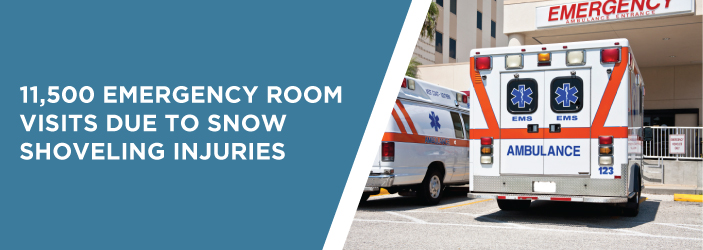
One of the most loathsome winter jobs is shoveling the driveway and sidewalk. It can take a long time and require a lot of physical exertion. The low temperatures make the task of shoveling snow even more unpleasant. The repetitive actions of twisting and lifting while shoveling can cause severe strain on the body. All it takes is one muscle to be pulled the wrong way for your back, neck or shoulders to seize up.
Snow shoveling can be a potentially risky duty that can cause severe injury. A national study found that over the course of eleven years, there was an average of 11,500 emergency room visits due to snow shoveling injuries. The most common injuries reported were soft tissue injuries mostly to the lower back region. Among the remaining injury reports, lacerations and fractures were also reported, including injuries to the hands, arms and head.
Driving and Collisions
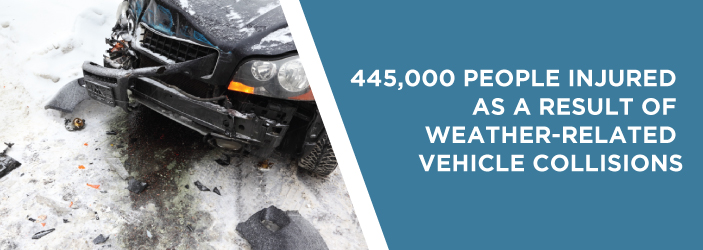
Most of us must continue to work and carry on with our normal, everyday activities even in snowy winter weather conditions. But if you aren’t prepared for winter driving conditions and don’t take the proper safety precautions, you can put yourself and others at risk. A study found that over a period of ten years, there were over 445,000 people injured as a result of weather-related vehicle collisions. The winter weather brings with it all kinds of potentially hazardous road conditions, such as:
- Wet pavement
- Sleet and slush
- Full coverings of snow and ice
Falling or Colliding During Winter Activities
One of the most enjoyable parts of winter is the fun you and your family can have with all kinds of winter activities and sports. From ice hockey and skating to skiing and snowboarding, there are plenty of ways to stay active and have fun in the winter. For kids especially, sledding and tobogganing are some of the best childhood memories of their winter seasons.
These winter activities can be quite risky if you aren’t practicing safety. Falls and collisions in many winter activities can cause several forms of injury. Broken bones and stiff muscles and joints are some of the most frequently reported injuries when it comes to outdoor sports and activities. Running outdoors along the sidewalk or on trails can also pose safety risks if the pavement isn’t salted and the trails aren’t properly cleared.
Types of Winter Injuries
These incidents produce various types of injuries, which can range from mild and easily treatable to severe and long-term. Some of the resultant injuries from these winter accidents most commonly include:
- Head injuries
- Shoulder injuries
- Back injuries
- Neck pain and tension
- Knee joint pain and soreness
- Wrist sprains
- Elbow fractures and dislocation
- Ankle sprains and strains
- Hip fracture and soreness
Head Injuries
Head injuries occur during the winter as a result of any number of incidents. Most commonly, falling on ice and hitting your head on the pavement can lead to a potentially serious brain injury. If this occurs, it will need immediate treatment by a physician. A brain injury can be difficult to treat, and often the symptoms won’t be noticed until long after the injury has occurred.
Head injuries can occur during winter activities like tobogganing, snowboarding and skiing, or one can also occur as a result of a motor vehicle collision, which has the potential to lead to serious long-term health consequences.
Shoulder Injuries
Shoulder injuries commonly occur when you fall on icy pavement. When your shoulder meets contact with the hard ice-covered pavement, dislocation can occur. This damage to the shoulder joint can be quite severe and leave you suffering from soreness and bruising for a long time afterward.
A torn rotator cuff can happen as the result of repetitive overhead motions from winter sports or shoveling snow. This muscle tear can leave you feeling sore and stiff and may result in a chronic injury as well.
Back Injuries
There are plenty of winter incidents and activities that can cause a back injury. The most common injury associated with shoveling snow is to the back, specifically the lower back. Back injuries can also be the result of a serious fall on the icy pavement or on the stairs. Falls during winter sports and activities can also result in a back injury.
Another common way to injure your back during the winter time is by scraping your car’s windshield to remove ice and snow. The bending and leaning motion your body performs while reaching across to scrape the ice can result in pulled and strained back muscles.
Depending on the level of severity, treating a back injury with heat may help to relax sore muscles. An injury that is caused by a fall on ice may damage your spine, so treatment by a physician will be required.
Neck Injuries
Like back and shoulder injuries, neck injuries can occur due to a number of different winter incidents. The repetitive motion of shoveling snow can certainly lead to stiffness and soreness in the neck muscles. Neck injuries can also happen when scraping snow and ice from your car’s windshield when your muscles become strained from leaning and reaching.
These injuries can usually be treated with a heating pad to relax tense neck muscles. If a neck injury is caused by a fall or a motor vehicle collision, it should be treated at the emergency room.
Knee Pain and Strain
High-impact winter sports can be very damaging to your knees over a period of time. This type of injury usually occurs while performing activities and sports such as skiing and snowboarding, where your knees are absorbing the shock of hard landings. Running outdoors on pavement can also cause a similar injury to your knees. The best thing to do with a knee injury is to take it easy until it heals, avoiding any high-impact activities.
Wrist Fractures and Strains
A fall on the icy pavement can cause wrist injuries such as fractures and strains. When you take a fall, your natural instinct is to extend your arms and brace your fall with your hands. The impact of the fall on your hands can cause a severe wrist strain or even fracture.
The result can be a serious injury if not treated properly. Your wrist may heal improperly, which could lead to chronic pain later in life.
Elbow Injuries
Like wrist injuries, elbow injuries can also arise from a fall on icy pavement. When you extend your arms to brace your fall, not only do your wrists take the impact but your elbows do as well. Your elbow could become dislocated if the impact is so significant that it pops your bone out of position. Otherwise, a more potentially severe injury could be an elbow fracture. This can lead to long-term pain if not treated properly.
Ankle Strain
Falls on slippery, icy pavement can also cause ankle injuries. When you struggle to recover your balance after slipping on ice, you can easily roll and twist your ankle. This may end up being a muscle injury whereby the tendon has been strained. Otherwise, a certain type of fracture in the ankle bone can result if more impact has been felt. This type of fracture can be caused not only by a fall on iced-over sidewalks, but also due to winter sports injuries.
Hip Fracture
Slips and falls on icy roads and sidewalks can result in many different types of broken bones, fractures and injuries. But one of the more severe injuries occurs when a fall is so hard and sudden that it fractures the hip bone. This can be a very difficult injury to repair, and it can also cause chronic, long-term pain. This injury especially affects seniors who are predisposed to osteoporosis or previous hip injuries. This injury should certainly be treated as an emergency by a physician.
Age Groups and Demographics Most Affected
Certain incidents and their resulting injuries may affect certain age groups more than others. It’s important to apply appropriate safety measures, so everyone can stay safe during the winter.
Children
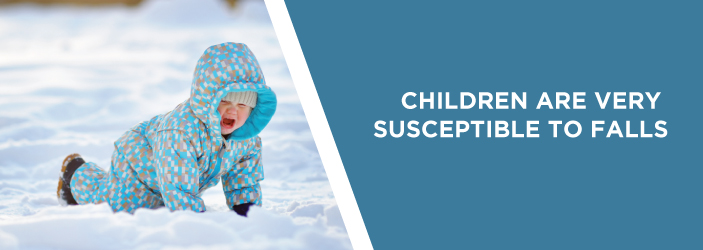
Children are susceptible to falls. They can easily fall and injure themselves if they can’t reach handrails or don’t have proper balance. If your child experiences a fall, it’s important to first assess their head for any injuries and then check for elsewhere, like wrists and elbows.
Children especially enjoy their time sledding and tobogganing, which can put them at risk for injury. Be sure to always supervise kids during winter activities and provide them with helmets to protect their heads.
Seniors
Like children, seniors are also at a higher risk of slipping and falling on icy pavement. Seniors can easily lose their footing and take a fall that can put them in severe danger. Seniors who have suffered in the past from hip injuries could further damage their hips or back. Seniors should be accompanied and helped down driveways and across parking lots to ensure they are stable and have the support to walk safely. Seniors with mobility issues may want to consider motorized scooters during the winter months for extra safety precautions.
Adults With Previous Medical Conditions
Adults with previous back, neck and shoulder injuries are also at risk to be severely injured in any of these winter incidents. A slip or a fall can trigger a past injury and can cause further damage. Additionally, adults with a predisposition to osteoporosis are also at higher risk for broken and fractured bones if involved in a collision or a fall.
Active Adults
Adults who remain active throughout the winter months are also at greater risk for injuries if proper safety precautions aren’t followed. Adults who ski and snowboard should be advised that, without the proper equipment, they can be at risk for head injuries as well as neck, shoulder, knee and ankle injuries.
People who run in the winter should be advised to use properly cleared and salted trails and sidewalks, so they don’t risk slipping and falling.
Winter Injury Prevention Tips
Though many of these winter accidents can be quite common, they are easy enough to prevent by following specific steps.
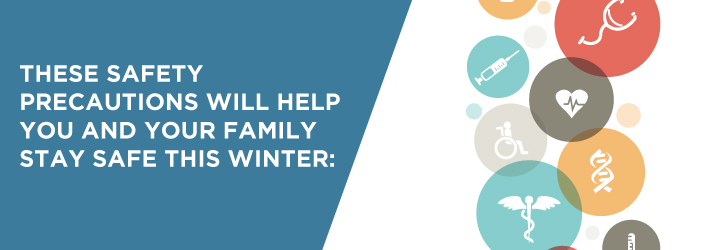
- Thoroughly and regularly salt driveways, sidewalks and stairs
- Walk carefully across parking lots and provide children and seniors with additional support
- Stretch before performing any physical exercise
- Stay hydrated while exercising and shoveling snow
- Ensure proper footing when shoveling snow or scraping ice off the car
- Wear a helmet and protective equipment during winter sports
- Always supervise children playing outdoors in the snow
- Before shoveling or scraping, make sure to properly stretch
Most businesses and shopping centers take precautions to salt their parking lots and sidewalks once winter hits. Even still, patches may be missed or ice may have formed since the last salting. When rushing into stores and shopping centers, slow down and take your time to carefully walk across the parking lot. Look for areas that have been clearly salted or do not appear wet. Hold onto children and seniors to help stabilize them as you walk across the parking lot or driveway and indoors.
For back injury prevention, it is advised to stretch lightly at first, then move into a deeper stretch. If you are going to be shoveling snow, then it’s important to stay well-hydrated and take frequent breaks so as not to exhaust your body and muscles.
When performing winter sports and activities, be sure to always have the proper protective equipment, like helmets, to prevent head and other serious injuries. If you have access to a gym or can use a treadmill at home, it will prevent any risk of slipping and falling while running outdoors during the winter.
If you choose to run outdoors, go with a buddy and be sure one of you carries a cell phone to call for help in the event of an injury. Familiarize yourself with your running route ahead of time to ensure it’s an area that has been salted and cleared of ice and snow.
Winter Driving Safety Tips
Winter weather can make driving more difficult, which means it can put yourself and others at risk of injury. In order to prevent motor vehicle collisions, follow these winter driving safety tips:
- Have proper winter-grade tires installed on your car
- Store an ice scraper in your car
- Keep windshield washer fluid full
- Have your vehicle inspected, especially breaks
- Have a winter safety kit in your trunk, including a high-visibility safety vest, gloves and jumper cables
- Keep a first aid kit in your car
- Never drive without a cellphone
- Limit the time spent driving in the dark
What To Do If You Suffer a Winter Injury
If you or a family member suffers a winter injury, it’s important to first assess the severity level. Sometimes muscle injuries can be treated with ibuprofen and by applying ice or a heating pad (whichever is more comfortable) or taking a warm bath. However, more severe injuries will need to be treated immediately by a professional. If you suspect broken or fractured bones or a head injury, report it to a physician right away, visit the emergency room or visit your orthopedic injury clinic.
Educate yourself and your family about the potential incidents and accidents that can occur during the winter, and you’ll be much more prepared to prevent them. If a serious injury occurs, be sure to contact OIP to schedule an appointment with a doctor who can treat you for your specific injuries. Follow these winter injury prevention tips, and you can enjoy a happy and safe winter season.


